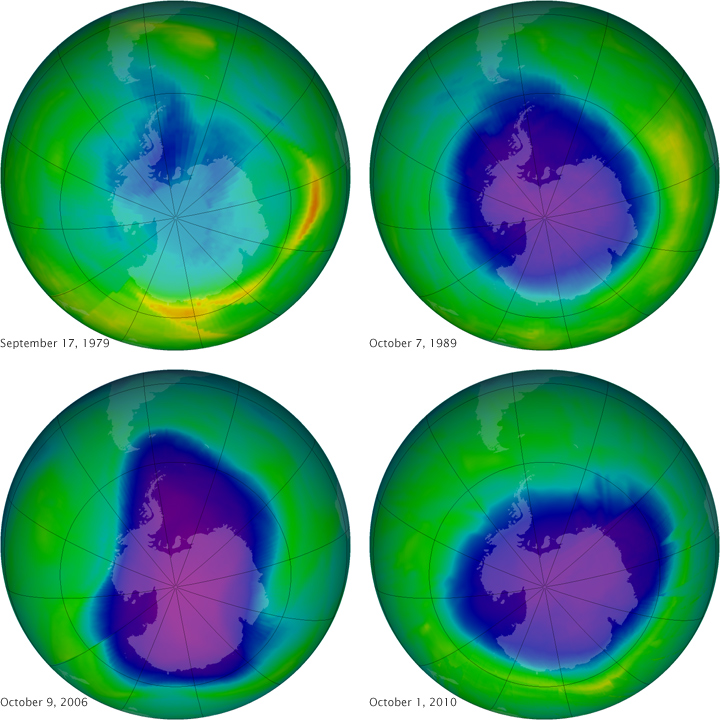|
Ozone Hole
through the years
Posted February 1, 2011 NASA Earth Observatory

Ozone is Earth's
natural sunscreen, shielding life from excessive amounts of ultraviolet
radiation. But Earth's ozone layer has been damaged by well-intentioned
chemicals—chlorofluorocarbons, used for refrigerants and aerosol spray-cans—that
have the unintended consequence of destroying ozone molecules.
In the late 1980s, governments around the world woke up to the destruction of
the ozone layer and negotiated the Montreal Protocol, an international treaty to
phase out ozone-depleting chemicals. The treaty included a requirement that
scientists regularly assess and report on the health of the ozone layer,
particularly the annual Antarctic ozone hole. In January 2011, the Ozone
Secretariat of the United Nations Environment Programme released its latest
report and noted that the Protocol has “protected the stratospheric ozone layer
from much higher levels of depletion...[and] provided substantial co-benefits by
reducing climate change.”
This series of images above shows the Antarctic ozone hole on the day of its
maximum depletion in four different years; that is, the days with the thinnest
ozone layer as measured in Dobson Units (DU). The measurements were made by
NASA’s Total Ozone Mapping Spectrometer (TOMS) instruments from 1979–2003 and by
the Royal Netherlands Meteorological Institute (KNMI) Ozone Monitoring
Instrument (OMI) from 2004–present. Purple and dark blue areas are part of the
ozone hole.
On September 17, 1979 (top left), the first year in which ozone was measured by
satellite, the ozone level was at 194 Dobson Units. On October 7, 1989 (top
right), the year that the Montreal Protocol went into force, ozone dropped to
108 DU. On October 9, 2006 (bottom left), ozone measured 82 DU. By October 1,
2010, the value was back up to 118 DU.
The lowest value (deepest hole) ever recorded was 73 Dobson Units on September
30, 1994, while the broadest hole occurred on September 29, 2000, when the
ozone-depleted area stretched 29.9 million square kilometers. The record for
mean size of the ozone hole—the greatest extent over a one-month window—was
September 7 to October 13, 2006, when the hole reached 26.2 million square
kilometers. The mean ozone hole in 2010 was 22.2 million square kilometers.
In their 2010 report, the science advisers to the Montreal Protocol found that:
• Global ozone and ozone in the Arctic and Antarctic is no longer decreasing,
but is not yet increasing.
• The ozone layer outside the Polar Regions is projected to recover to its
pre-1980 levels some time before the middle of this century. The recovery might
be accelerated by greenhouse gas-induced cooling of the upper stratosphere.
• The ozone hole over the Antarctic is expected to recover much later.
• The impact of the Antarctic ozone hole on surface climate is becoming evident
in surface temperature and wind patterns.
• At mid-latitudes, surface ultraviolet radiation has been about constant over
the last decade.
http://earthobservatory.nasa.gov/IOTD/view.php?id=49040&src=imgrss
|




